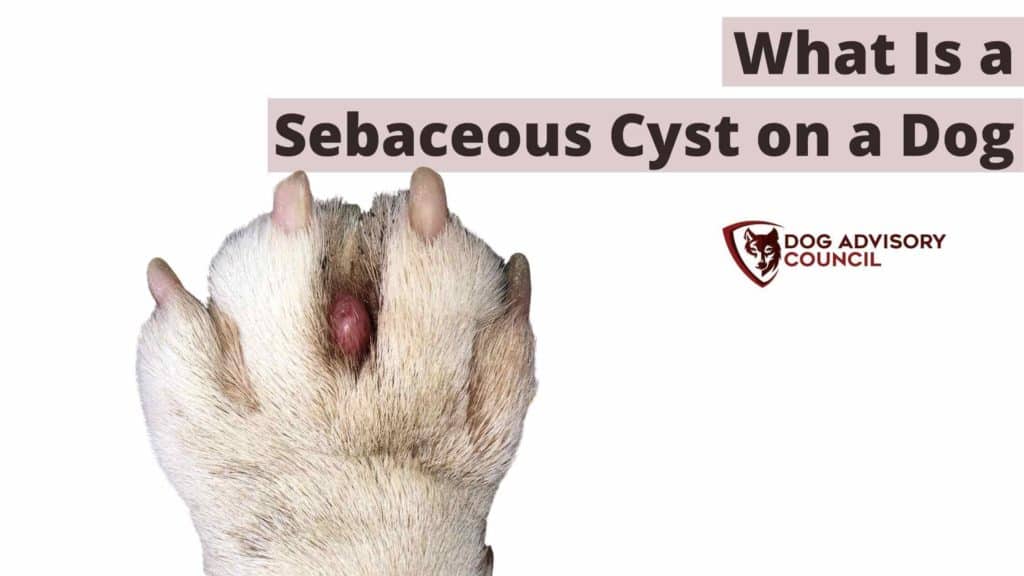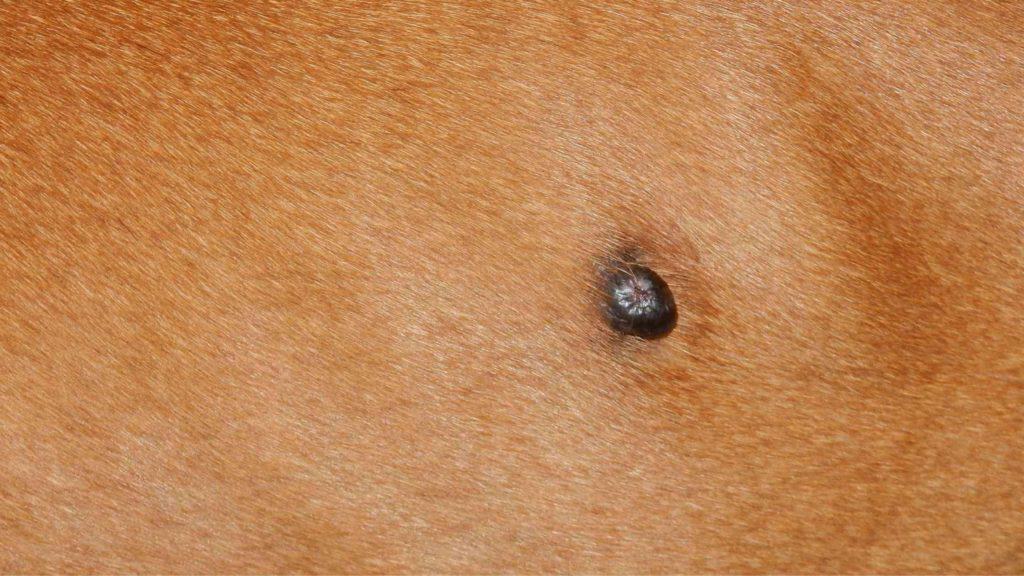
Notice a new bump on your dog that has you worried? It could be a sebaceous cyst.
A sebaceous cyst is a fancy term that is used to describe a bump that appears as a result of a clogged oil gland under the skin of your dog.
These glands are how dogs sweat and release natural oils to keep fur healthy and shiny.
Sometimes, they get blocked by hair follicles, which leads to the oil forming a cyst since it has nowhere to go.
Below is what you need to know about what it looks like, where it comes from, and how you can treat it!
Are cysts in dogs common?
Sebaceous cysts are very common in dogs. They can appear at any age and are popular with all sorts of dog breeds.
Cysts are so common in many situations that most pet owners don’t even know that their dogs have them half the time unless they are in the habit of looking for them.
Are sebaceous cysts on dogs bad?
While common, sebaceous cysts are a reason for concern. If you spot one on your dog, you should always bring him in to the vet to make sure that everything is okay.
Cysts can be prone to infection and may even indicate more severe health problems, like cancer. In most cases, however, sebaceous cysts are benign.
Are sebaceous cysts on dogs painful?
Most people realize that their dogs have a sebaceous cyst because they start to pay attention to it.
If your dog is licking it or picking at it, it’s a sign that it is bothersome or painful for your dog. They can be painful, especially if they are infected.
In some cases, however, they are invisible to your dog. That is, they don’t even know that they’re there! It depends on the size and any potential friction. The more it is touched, the more painful it can be for your dog.
Common places for sebaceous cysts on dogs
Technically, sebaceous cysts can appear anywhere on dogs since they are caused by blocked oil glands, which are everywhere on the body.
However, there are some places on the body that tend to be prone than others:
- Snout
- Bum
- Trunk (belly, especially)
- Paws
- Elbows and wrists
These are popular locations for cysts because they get a lot of interaction with the environment around them. This leads to friction and the potential for cysts to rise up and be irritated, leading to symptoms like pain in your dog.
Causes for sebaceous cysts on dogs
All things aside, sebaceous cysts can appear just because a follicle is in the way when the body secretes its oil.
That being said, some other contributing factors can lead to it being more and more common. These include:
- Genetics
- Playing in dirt
- Injury/insect bite/allergic reactions
- Lack of grooming or brushing
- Sebum production issues
- Hormonal changes
If dealing with genetics, you’ll be able to get used to what a sebaceous cyst looks like and how to deal with it regularly. This will make you a “seasoned pro” so that if something does happen in the future, you’ll be able to spot right away when a cyst appears out of the ordinary or your dog seems to be bothered with it.
To prevent any from popping up without reason, always focus on the idea of keeping your dog clean well-groomed. This will help their fur and skin stay as healthy as possible.
Since grooming helps stimulate oil production and secretion, proper grooming (at home or in a dog salon) can be a great preventative option to prioritize. It also enables you to bond with your dog, which is really important.
What does a sebaceous cyst look like on a dog?
Not quite sure just what you should be looking for when it comes to a sebaceous cyst?
You’ll notice that it will appear to be a raised bump under the skin. It may appear white or slightly yellow (this is the sebum built up within it).
It should be somewhat mobile and soft to the touch (not hard). They are often round but can be oval-shaped, too. Most tend to be 1-2 inches (2.5-5 cm) in size.

Can I drain a cyst on my dog?
You shouldn’t try to drain the cyst on your own. Even if you are confident that it is a cyst, the only ones that should attempt to drain it should be vets. Most of the time, they won’t do that unless absolutely necessary.
How do you get rid of a sebaceous cyst on a dog?
There are three main ways that you can help your dog get rid of a sebaceous cyst.
The way you choose most often depends on its size, your dog’s comfort, and your vet’s recommendation on seeing it:
- Drain and heal
- Wait it out
- Surgical removal
Drain and heal
A vet will use medical-grade tools to pierce the cyst and drain it safely.
Sometimes your dog might be put under anesthesia if needed to help keep them steady.
In most cases, local pain relief is offered to keep your dog from noticing what’s going on.
Once the cyst is drained, the vet will prescribe antibiotics to prevent any infection while it heals, and it will scab and fall off over days or weeks.
Wait it out
This is typically the first approach your vet will take.
Waiting to see if it drains or simply goes away on its own is noninvasive, free, and doesn’t stress out your dog.
If the cyst isn’t in a problem spot, this is the most recommended option for pet parents and their dogs to consider.
Surgical removal
In cases where the cyst returns continuously, or it is causing pain to the dog (or the vet feels that something is wrong), they can recommend surgery.
In this case, it will be cut free from your dog so that nothing can grow back. Antibiotics will follow up the surgery to help keep the site clean as it heals.
How do you treat a cyst on a dog?
If you’re in a situation where the cyst bursts on its own at home, you’ll want to call your vet and book your dog in for an appointment as soon as you can.
In the meantime, however, you can simply keep the area clean and as dry as possible. If your dog is picking at it, consider a cone or another kind of therapeutic option that will block him from attacking the wound as it heals.
The better care you take of it at home, the better chances will be at avoiding infection.
Why do old dogs get sebaceous cysts?
As mentioned, dogs at any age can get sebaceous cysts. However, senior dogs are much more likely to have this problem.
Their sebum production slows down as they age, and their hormone levels often go out of whack. This combination creates more chances for blockages to occur and for the cysts to form.
Many don’t groom their senior dogs as much, so the follicles don’t get as much stimulation as needed, creating more growth opportunities.
As well, dogs who have problems such as hip dysplasia or other muscle-related health complications as they age can be more prone to cysts in and around those problem spots. The skin breaks down and weakens, making cysts much more likely.
When to visit a veterinarian
It’s always a good idea to visit a veterinarian when you are looking at doing the right thing for your dog’s health.
A cyst is technically a growth, and there can be situations where a cyst isn’t benign.
You’ll want to book your dog in with a vet you trust to have a biopsy done as soon as you can. Plus, it’ll be great peace of mind for you, too, if you want to make sure that our dog is going to be okay.
As well, cysts are commonly infected, as mentioned. The sooner you know what’s going on and how to deal with it, the better health your dog will be in.
Ultimately
In dogs, sebaceous cysts are blockages of sebum glands that create a swollen follicle for trapped sebum to escape.
They can appear all over the body and are common in all dog breeds and ages. They can be infected and can sometimes be cancerous, making vet treatment important.
Although sebaceous cysts are not a popular subject of conversation in dog parks or among friends with dogs, they are critical to understand as a pet parent who wants to ensure that their dog is healthy!
If you know someone who could use a little extra information, consider sharing this article with them to help them stay cyst-wise!
